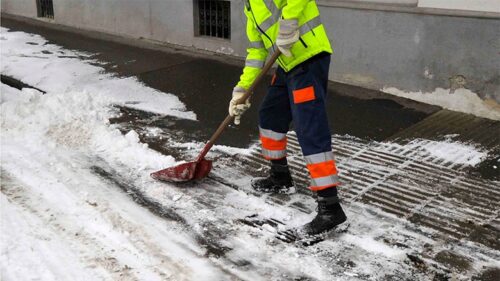
12.20.22 – ISHN – By Rick Pedley
Follow these tips to prevent cold stress and winter-related injuries.
Cold temperatures can be a danger to employers and their workers. The human body can only tolerate so much exposure to the cold. Once the body can no longer warm itself, the person may experience a range of painful conditions, including chilblains (painful inflammation of blood vessels in the skin that causes itching, skin ulcers, swelling, burning, and red patches), trench foot, frostbite, and hypothermia.
Workers are at risk of cold stress when exposed to temperatures below 32 degrees Fahrenheit (0 degrees Celsius). Sustained exposure to freezing temperatures can lead to permanent injury and even death. Others, such as those with poor circulation and existing health issues, may be more susceptible to lower temperatures, increasing their risk of injury.
The cold can also make it harder for workers to do their job. They may have trouble gripping tools and objects or working outdoors for long periods of time. Freezing rain, ice, and snow increase the risk of trips, slips, and falls. Employers must take precautions to prevent winter-related injuries, including cold stress, when employees are working in a cold environment.
Who is at risk?
Individuals that work outdoors for a living are the most susceptible to cold stress and other winter-related injuries, including those in the construction, agriculture, fishing, and emergency response industries. These individuals typically work outside, regardless of the weather. They also face an increased risk of slipping or falling if the ground is wet, frozen, or covered in snow.
But workers don’t have to be outside to experience the cold. Those that work with or in cold storage containers and freezers may also be at risk of cold stress, including butchers, warehouse workers, and those in the pharmaceutical industry. Anyone working or occupying a space that is under 32 degrees Fahrenheit will need to take precautions to protect themselves from injury.
Evaluating the potential risks
Employers and organizations dealing with these risks should first conduct a safety evaluation to identify specific hazards. OSHA doesn’t have a specific standard for those working in cold environments, but employers are responsible for protecting their workers from harm.
The company should start by recording and tracking the temperature of the work environment to get a sense of whether their workers are at risk. The team should account for sudden temperature changes and adjust their calculations for the wind chill.
By checking the weather regularly, managers should also account for possible snowstorms and excess moisture, which could cause the ground to freeze over. This is particularly dangerous for employees working on elevated surfaces. Additional barriers and fall protection may be required.
Reducing employee exposure to cold weather
Once the company has identified all possible risks, the team should do everything possible to reduce employee exposure by making changes to the work environment.
Relocating workers indoors will help protect them from the cold. If working outside is unavoidable, the team should consider working outside during the warmest hours of the day and avoid being outside during hazardous conditions. Workers should have ample time to rest during the shift with access to a heated break room to warm themselves whenever they aren’t working. This may include rotating workers in and out of the cold environment.
When faced with winter weather, the team will need to clear away the snow and break up the ice with salt before workers begin their shift. Individual employees should look for ways to remove the ice or snow without going on elevated surfaces or occupying hazardous areas. If occupying these areas is unavoidable, the team should test the surface to see if it is structurally sound.
If the environment is below freezing, the company should develop a cold stress response strategy so workers know how to respond in an emergency. This may include relocating the person to a warmer environment, applying first aid to injuries, and alerting the proper authorities. The company should also have a plan in place to deal with winter-related injuries. If an area cannot be made safe for human occupation, it should be closed off to personnel with the appropriate signage.
Cold weather PPE
Everyone working in a cold work environment will need to wear the proper winter gear, including thick pants, boots, jacket, gloves, and earmuffs or hat, to stay warm in the field. Workers should be able to add extra layers as needed as the temperature changes. The outermost layers should be waterproof, and workers will need to cover as much of their skin as possible. The sleeves of their jacket should extend over the gloves, and the pant legs should extend over the socks and boots to prevent moisture from slipping inside. Even though workers will be out in the cold, they can still work up a sweat, so breathable, quick-drying and moisture wicking clothing should be considered. Employers should provide additional layers and warming materials for those who need them, including hand warmers, extra gloves, hats, and thermal clothing. The clothing should come in a wide range of sizes to accommodate everyone’s needs. The clothing should be comfortable and neither too tight nor too loose. If working in harsh outdoor conditions like heavy rainfall or a snowstorm, high visibility clothing and PPE should also be worn, so workers can be seen and stay safe.
Workers should monitor their body temperature throughout their shift and check themselves for symptoms of cold stress, including fatigue, confusion, disorientation, excessive shivering, and loss of coordination. Individuals should have access to dry, warm areas if they are feeling fatigued or losing feeling in their extremities.
Employers are responsible for providing a safe work environment for their employees. Everyone will need to do their part to prevent winter-related injuries. Once the work environment has been cleared of all possible hazards, workers should use PPE to protect themselves from the elements. The weather can change without warning, and companies need to be prepared for anything.
